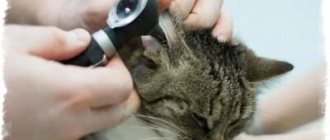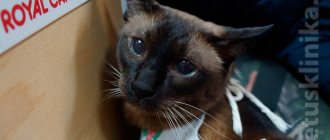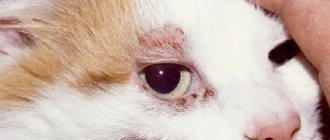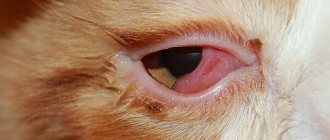When a cat's eyes are watery, it is better to go to the veterinarian, as this is most likely conjunctivitis. Conjunctivitis in cats is a fairly common disease that occurs not only in animals walking outside the home. Moreover, eye inflammation is a harbinger of various infectious diseases. In our article we will try to reveal the main causes, symptoms and treatment of this disease, and also talk about the main preventive methods.
Causes of conjunctivitis in cats
The main reasons are:
- Foreign bodies that get into the pet's eyes (this can be dust, wood chips, sand, or other objects that can damage the eye).
- Getting various chemicals and household substances into the eye - this can happen while swimming.
- Conjunctivitis in cats is often caused by a herpesvirus infection that affects the mucous membranes of the eyes and nasal cavity - in such cases, viral conjunctivitis occurs.
- One of the reasons may be the transfer of inflammation from nearby tissues, such as the skin of the eyelids (blepharitis), the mucous membrane of the nasal cavity (rhinitis).
- Acute infectious diseases that cause various complications, including conjunctivitis - carnivore plague, rhinotracheitis, panleukopenia.
- Chlamydia and mycoplasmosis, and other bacterial infections can also cause conjunctivitis.
- Injuries received during play or fights with other animals open the gates for the development of inflammation.
- Surprisingly, cats, like humans, can suffer from allergies to pollen, dust, perfumes and food - these can also serve as catalysts for illness.
Main reasons
There are many reasons for the development of eye inflammation:
- Mechanical causes are eye injuries, the presence of foreign bodies.
- Chemical causes are irritation resulting from contact with gases, vapors, and acids.
- Infectious causes.
- Transition of the inflammatory process from one area to another.
- Allergens. A similar illness can arise from plant pollen or the host’s new perfume. In this case, it is necessary to observe what factor caused the irritation and eliminate it from everyday life.
Unfortunately, many owners, having discovered conjunctivitis in a kitten, are in no hurry to treat it at the veterinarian, but this ailment can be a harbinger of a serious infectious disease, and this cannot be done without consulting a veterinarian.
Symptoms of conjunctivitis in cats
The clinical manifestations of conjunctivitis depend on the course of the disease:
- the acute course is accompanied by the sudden onset and clear clinical signs of inflammation with copious discharge;
- subacute clinical course is slightly weaker than acute;
- The chronic course is characterized by slow development, long course and mild clinical manifestations.
General symptoms of all conjunctivitis in cats:
- Redness of the mucous membranes of the eyes;
- Swelling of the eyelids;
- Cats have watery eyes;
- Discharge from the eyes - from mucous to yellow-green purulent;
- Constant attempts by the cat to “wash” the eyes;
- Souring of the eyes after sleep, sticking with dried pus;
- Pain when blinking, squinting, fear of light;
- Sometimes a cloudy film on the cornea is visible.
Depending on the duration and severity of the course, conjunctivitis is divided into:
- Acute, when symptoms appear very quickly, cause severe discomfort to the patient. Sometimes they may be accompanied by low-grade fever, headache and insomnia. Symptoms last up to four weeks;
- Chronic - the disease lasts longer than a month and is recurrent in nature.
Types of conjunctivitis
There are the following types of this disease:
- Catarrhal conjunctivitis
is the most harmless and easily occurring. In this case, the eye is red, the mucous membrane swells somewhat, and the animal experiences pain when trying to open its eyes. They are constantly crying. The temperature usually remains within normal limits. Sometimes, with severe injuries, protrusion of the edematous conjunctiva in the form of a roller from under the eyelids is observed. - Purulent conjunctivitis
occurs when the infection has already completely spread in the eye. It is quite difficult to overlook such an ailment, since this form of the disease has obvious signs in the form of yellow or green discharge. The inflamed eye does not open at all. The general condition of the cat is depressed (lethargic), the local temperature is increased, the eyelids are swollen, the mucous membrane is red. The pet develops photophobia. The discharge from the eyes is first liquid, then thick, gray-yellowish and accumulates on the edge of the eyelids, forming crusts. - Follicular conjunctivitis
is a dangerous and life-threatening type of inflammation. In this case, the infection penetrates lower and affects the lymphatic follicles. The eye increases in size. After diagnosis, the doctor prescribes serious treatment, which may include surgical intervention. This type of conjunctivitis in cats is often caused by mechanical irritants (foreign bodies, dust) or occurs as a complication of infectious diseases. It develops slowly, accompanied by minor mucopurulent discharge. On the inner surface of the third eyelid there is a cluster of enlarged follicles of a dark red color, resembling ripe raspberries in appearance. Typically, both eyes are affected at the same time. - Phlegmonous conjunctivitis
is a complex type of inflammation. In this case, conjunctivitis affects not only the surface of the mucous membrane, but also the inside of the eye. It is quite difficult to save them, but with timely rehabilitation it is quite possible. This type of disease is characterized by a ring-shaped protrusion of the conjunctiva through the palpebral fissure. The surface of the conjunctiva itself is glassy, shiny and lumpy, bright red. Then the cat may develop bleeding ulcers. Serous-mucous or purulent discharge is also noted. - Allergic conjunctivitis
is a complication of an allergic reaction, most often due to feeding inappropriate food. If your cat has watery eyes, you should take the animal to the veterinarian, as there is a possibility of infection.
The conjunctiva is a source of inflammation
The conjunctiva is the thinnest mucous membrane in which the inner sides of the eyelids and eyeballs are “sealed”. The upper eyelid has a more dense mucous membrane, similar to a pillow. There is also a third eyelid - it is almost invisible in the inner corner of the eye. But when inflammation occurs, the disease is first visible in the third eyelid.
This mucous membrane contains additional ducts for the tear glands, helping the eye stay moist and protected from small foreign objects. Everyone has encountered a situation where a midge or a grain of sand got into their eye. The lacrimal glands immediately actively “pushed out” the foreign body with their fluid, and the eye could function freely again. Cat's eyes have the same physiological properties. Inflammation of the conjunctiva, the protective layer of the eye, is called conjunctivitis.
Diagnosis of the disease
In order to accurately establish a diagnosis, a number of conditions must be met, such as collecting primary data to establish the cause (history), which includes clarifying a number of questions: whether the animal is vaccinated regularly annually, whether there was contact with other animals that looked sick. Redness occurs in one eye or both. How long ago did the owners notice, are there any other changes, what is the nature of the discharge from the eyes, etc. Then the doctor must look at the eyes using special instruments. If necessary, blood biochemistry and infectious diseases tests, bacteriological studies, and cytological studies of scrapings from the conjunctiva are taken.
It won't go away on its own. What is the danger of untreated conjunctivitis?
Firstly, the lack of help increases the risk of developing a chronic form of the disease, in which the conjunctiva will become inflamed regularly. Some people prefer to look for folk remedies on the Internet, but doctors do not approve of self-medication - it can only worsen the situation. You need to act precisely, and herbal compresses are not able to cure the original cause. In order to heal your eyes as quickly as possible and avoid negative consequences, at the first symptoms you need to begin treatment under the supervision of a doctor. Be prepared for the fact that it may take 7 to 14 days for complete recovery.
Another danger is that if treated improperly, another eye pathology may be added to conjunctivitis, and the infection may spread. This threatens:
- Blepharitis (damage to the eyelids);
- Keratitis (inflammation of the cornea);
- Endophthalmitis (disease of the internal structures of the organ of vision);
- Panophthalmitis (acute purulent inflammation of all tissues of the eye;
- Cyclitis (inflammation of the ciliary body);
- The appearance of scars, deterioration or loss of vision;
- In children, severe conjunctivitis can affect the formation of the eyeballs. In very young children, infections can even spread to the respiratory tract and cause bronchitis or pneumonia.
Treatment of conjunctivitis in cats
It is quite difficult to treat sick cats with conjunctivitis, despite a significant arsenal of medications and methods of their use. Treatment for the disease depends on its type. Treatment of conjunctivitis in cats should be carried out under the supervision of a veterinarian. The choice of means depends, first of all, on the severity of the process and the type of conjunctivitis.
First, the animal's eyes must be cleaned of foreign secretions. This is done with cotton wool and a solution recommended by the doctor. Particular attention should be paid to the pouch, which is located near the animal’s eye. Feline conjunctivitis is a rather dangerous disease, and if the therapy is chosen incorrectly, the pet may lose its vision. It is worth remembering that during this period the animal’s immunity weakens, therefore it is extremely important to give it immunomodulators (subcutaneous FORVET is recommended).
Depending on the cause of the disease, the animal is prescribed antibacterial drops or ointments based on antibiotics, which help fight conjunctivitis, as well as local antiviral drugs to treat viral conjunctivitis, such as FORVET eye drops, one drop 4-5 times a day. If necessary, surgical intervention is performed to eliminate the causes (elimination of entropion, removal of the third eyelid).
When should you contact a doctor?
If you notice these symptoms, you should contact your ophthalmologist on the same day. It is best to do this remotely until you pass the PCR test for coronavirus, so as not to put others at risk. Doctors recommend especially carefully monitoring the first signs of conjunctivitis for those who have already been diagnosed with other diseases, as well as for those who often suffer from eye infections.
Contact your eye doctor as soon as possible if you:
- Diabetic retinopathy;
- Macular degeneration (macular degeneration);
- Vision deteriorated sharply.
Prevention of conjunctivitis
To prevent the development of conjunctivitis in your cat, you should follow a number of measures. For example:
- Try to carry out annual vaccinations and regularly give anthelmintics, since viruses and helminths can be the root cause of the disease.
- Support your pet's immune system with immunomodulatory agents.
- Protect the cat from getting foreign bodies and chemicals into the eyes. Clean more often, handle hygiene products carefully, and put household chemicals away.
- Limit your pet's contact with other animals, especially stray and obviously sick ones.
- Wash and disinfect your hands thoroughly after contact with sick animals before interacting with your pet.
Thus, conjunctivitis in cats is not uncommon. However, there is nothing to worry about; with timely treatment, you can get rid of the disease once and for all.
How to protect your eyes?
If you go outside, keep your distance and wear safety glasses or face shields along with a medical mask, because it helps evaporate the tear film, the eye's natural protective barrier. Follow standard hygiene rules to protect against infection, try not to rub your eyes, it is better to relieve itching with moisturizing drops. Contact lenses do not help prevent coronavirus infection through the eyes, but they do not increase the risk of infection, so they can be used as usual. But do not forget about the rules for caring for them and timely replacement.










